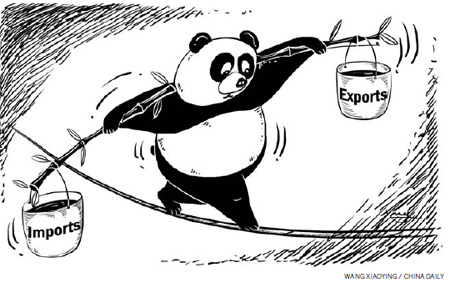
How China's external current account surplus will evolve in the coming years is one of the key questions on the economic outlook for China and the global economy both.
China's increasingly competitive manufacturing sector should continue to power ahead to expand exports and gain global market share. At the same time, China's domestic economy should continue to grow rapidly, drawing imports. But how this will on balance play out with regard to the current account surplus is less certain. It will largely depend on how much progress is made with rebalancing the economy.
China's export volume has continued to rise rapidly. An increasing array of its manufacturing sector, including many types of machinery and equipment, is becoming more competitive internationally.
Competitiveness is boosted by technological catch-up, movement up the value chain and economies of scale, as well as through traditional strengths such as infrastructure and business climate. Reflecting these factors, labor productivity growth in manufacturing has remained solid, thus helping contain unit labor costs despite respectable wage growth.
Some have argued that China is losing its competitive edge because its export prices are rising. But that is an incorrect inference. Higher raw commodity prices mean export prices are rising all over the world - not just in China. Prices of US imports from China are now rising at the same pace as those of US imports of manufactured goods from developed countries. But prices of US imports of manufactured goods from other emerging markets and developing countries are rising faster. On this price metric, the most we can say is that China's competitiveness is improving at a slower pace than before.
China's exports have continued to strongly outpace world trade, and their global market share rose from 7.4 percent in 2007 to about 9.6 percent in 2010. And the trend has continued in the first four months of this year.
In addition to the strength of gross exports, the value added content of China's exports has continued to rise. This is because of deeper supply chains in the processing sector and a rising share of normal (non-processing) exports, which have higher value added content. In value added terms, exports thus grew even somewhat faster than headline exports. In several parts of the world, this strong export performance is causing economic and sometimes political friction.
There is another side to China's external trade story. Its domestic economy has grown even faster than exports since 2007, and its imports surged alongside domestic demand. As a result, imports strongly outpaced exports, with import volumes 34 percent higher in 2010 than in 2007, in real terms, compared to a 24 percent increase in the export volume.
This basically caused the decline in China's current account surplus from 10.1 percent of GDP in 2007 to 5.1 percent in 2010, leading to external rebalancing because China grew much faster than the rest of the world. In the first four months of this year, the growth of import volume eased but still maintained a steady pace.